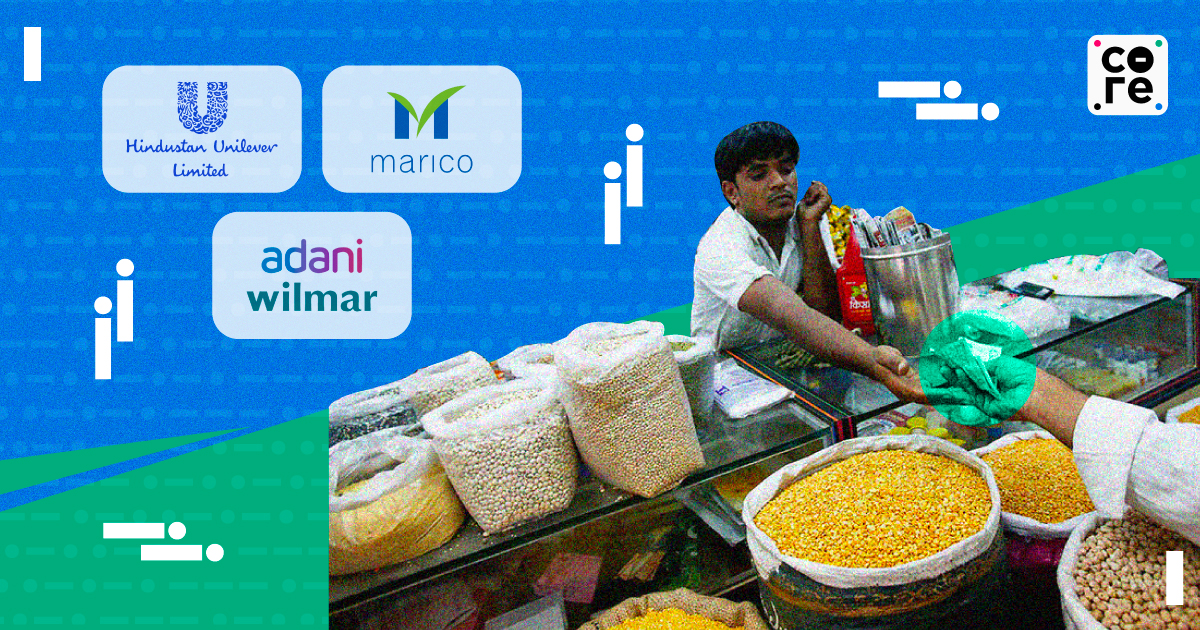
Weak Rural Demand, Tepid Monsoons Made 2023 A Bad Year For FMCG Companies
While urban demand remained robust, rural demand was hit by multiple factors like high retail inflation and inadequate monsoons which impacted rural purchasing power.

Weak rural demand, erratic monsoons, and a tepid festive season made 2023 possibly the worst in almost 30 years for the fast-moving consumer goods (FMCG) sector. Packaged products like snacks, detergents, and soaps had low rural demand, triggering concerns over FMCG sales volumes.
The rural demand slump in the previous five to six quarters was the longest in a decade and FMCG companies are hoping for a recovery in the next few quarters. In the October-December period of 2023, several FMCG companies recorded volume growth over value growth driven by a decline in prices.
“The third quarter for the FMCG trade is supposed to be the highest sales quarter for the entire year. Unfortunately, we have lost that quarter completely. Most of the sales are negative in that quarter… this year seems to be a black year for the FMCG segment, as taken all together, in the last three decades, we have never seen negative growth or a negative trend in an entire FMCG segment,” Dhairyashil Patil, president of All India Consumer Products Distributors Federation, told The Core.
What Numbers Show
Consumer goods majors like Marico, Dabur, Godrej Consumer Products, and Adani Wilmar, attributed their growth during the October-December period to an increase in volumes. Volume-led sales growth was primarily driven by a reduction in prices early last year to pass on the benefit of lower raw-material costs to consumers.
Colgate-Palmolive (India) reported a 35.7% jump in third-quarter profit due to good urban demand and a fall in expenses. For consumer goods makers, sales were boosted by urban consumers with higher average incomes, even in the face of elevated prices of essential goods. Sales increased 8.2% to Rs 1,386 crore from Rs 1,281.21 crore in the same period a year ago.
Hindustan Unilever posted a smaller-than-expected quarterly profit increase as rural markets remained weak. It reported a volume growth of 2% for the October-December quarter, which was flat on a sequential basis and was lower than the 5% volume growth it reported during the same period last year. Adani Wilmar posted the best-ever volumes in branded oil and foods in the last quarter. The company’s sales volume grew 6% from a year earlier and lower pricing of edible oils due to decreasing raw material costs led to a 15% decline in revenue.
There was a general demand slowdown because of weak rural purchasing power as well as a tepid festive season. The lack of adequate monsoon last year was bad news for crop production which also had a bearing on rural purchasing power. All factors together led to people becoming more cautious about their purchases. “They are spending very wisely and only on bare minimum necessities. They are going for smaller packs. The second thing is that is their income growing? We don't see any jobs growing right now,” Patil said.
Also Read: Recovery Firms Thrive As Bureaucracy Keeps People From Claiming Their Own Money
Urban-Rural Disconnect
While urban demand remained robust, rural demand was hit by multiple factors. High retail inflation and inadequate monsoons hit rural purchasing power, which is evidenced in lower tractor sales in October, which fell 5% to 117,714 units from 123,526 in the same period a year ago, according to data from Tractor Junction, an online aggregator for tractor and farm equipment.
This was reflected in the flattening of festive demand. “Festival season is a classic indicator of how discretionary products will sell. Even then, whilst stocking happened in stores, we now see a big struggle to liquidate those stocks, which means consumption has not followed. And I think that's really been a challenge. And I think that has really led all brands to look inward,” Akshay D' Souza, chief of growth and Insights, told The Core.
Expectedly, urban demand continued to be robust. “The pace at which the rural was growing in the last three, four years was higher than the urban population. And now we are seeing a slowdown in the rural population,” Patil said.
The behaviour of the urban consumer also changed toward discretionary spending. Consumers splurged on luxury goods and experiences, as seen in the trend across segments, from watches to cars. A Deloitte study on consumer sentiments said that the overall luxury market in India is estimated to grow to $30 billion by 2030, with 60% of existing consumers spending on luxury, across product segments, every year.
“Discretionary spending is also going to be fueled by the cost of essentials going down. I think that seems to be one clear indicator because when you have more cash available to spend, you will probably go and end up spending on discretionary. That's definitely in the offing,” D' Souza said.
Also Read: On The Shopfloor: Toy Manufacturer Playgro Toys Says Industry Needs PLI Scheme
Why Consumers Are Now Returning To Physical Stores To Buy Their Gadgets
While urban demand remained robust, rural demand was hit by multiple factors like high retail inflation and inadequate monsoons which impacted rural purchasing power.

